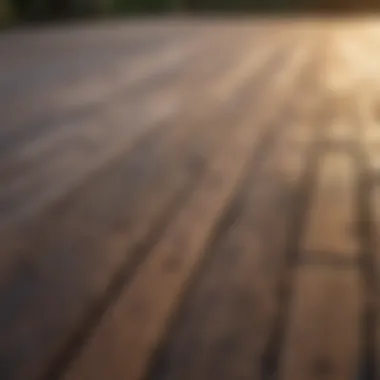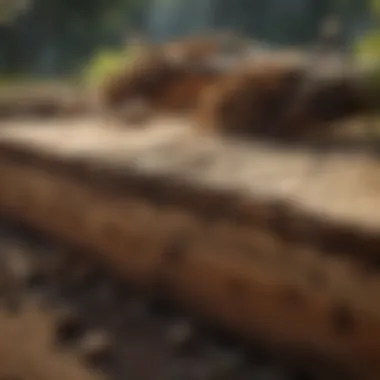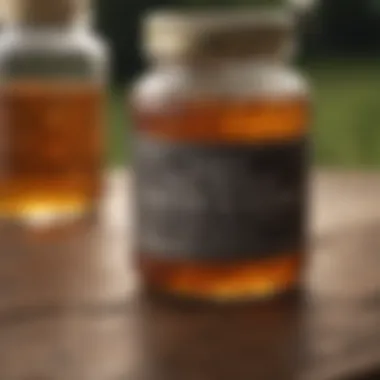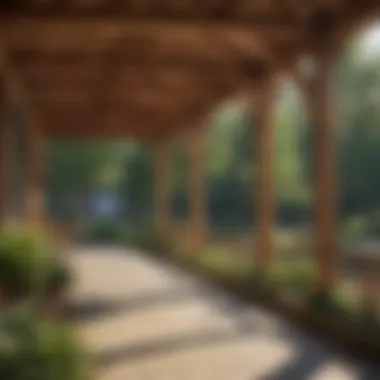Effective Treatments for Outdoor Wood Preservation


Intro
Maintaining outdoor wood isn't just about aesthetics; it's about ensuring the durability and longevity of structures that can withstand Mother Nature's whims. Proper treatment is crucial for everything from decks to fences, allowing these materials to hold their ground against rot, pests, and the scattered whims of the weather. For agricultural enthusiasts and gardening professionals, understanding the optimal treatments not only can save you time and money but also extends the lifespan of your outdoor wood assets.
Key Concepts and Terminology
Basic Definitions
When discussing outdoor wood treatment, several terms come into play:
- Preservative: A chemical used to protect wood against decay, insects, and fungal growth.
- Sealant: A product applied to the surface of the wood to protect it from moisture and other external factors.
- Stain: A coloring agent that penetrates wood, enhancing its appearance while providing some protection.
These definitions set the stage for deeper exploration into the nuance between treatments, as selecting the right product can feel as intricate as navigating a maze.
Historical Context
Historically, outdoor wood preservation can be traced back to ancient techniques where natural oils were used for waterproofing. Over the centuries, as technology evolved, so too did the methods for preserving and treating wood. From the early use of linseed oil to modern chemical solutions, the journey reflects a blend of art and science, with changes driven by both functionality and environmental concerns.
Recent Innovations and Trends
Technological Advancements
One cannot overlook the influence of technological advances in developing more effective treatment options for outdoor wood. For instance, nanotechnology has led to the creation of wood treatments that can deeply penetrate wood fibers, providing longer-lasting protection while being eco-friendly. Moreover, water-based treatments have risen in popularity, offering effective solutions without the harsh chemicals of the past.
Sustainable Practices
In recent years, a noticeable shift towards sustainable practices has taken root. Many farmers and gardeners are now turning to treatments derived from natural sources, such as plant-based oils and waxes. This trend not only appeals to the environmentally conscious but also aligns with the growing demand for organic farming practices. By opting for sustainable treatments, one can significantly reduce their carbon footprint while maintaining the integrity of their outdoor wood.
Practical Applications and Techniques
Step-by-step Guides
To optimize the preservation of outdoor wood, consider these straightforward steps:
- Assessment: Examine the wood for signs of damage, rot, or insect infestation.
- Preparation: Clean the surface thoroughly. Remove dirt, mildew, and old finishes.
- Choosing Treatment: Depending on your needs, select a preservative, sealant, or stain.
- Application: Follow the manufacturer's instructions for application—using a brush or spray depending on your chosen product.
- Curing: Allow adequate drying time before exposing the wood to the elements.
Taking these steps ensures you are well on your way to safeguarding your wooden structures.
Case Studies
To illustrate the effectiveness of treatments, let's examine a few practical case studies:
- A community garden utilized a natural wood oil treatment, resulting in doubled longevity of their raised beds compared to untreated wood.
- A local vineyard adopted a waterproof sealant for their outdoor storage, which effectively kept moisture at bay during heavy rains, preserving the integrity of their tools and materials.
"Outdoor wood deserves as much care as any plant; treat it right, and it will serve you well for years."
As we dive deeper into this topic, we will explore specific products and techniques, providing you with a comprehensive toolkit to enhance both the durability and aesthetics of your outdoor wood.
Foreword to Outdoor Wood Treatment
In the realm of horticulture and agriculture, the treatment of outdoor wood remains a critical facet often overlooked by many enthusiasts. It's not just about aesthetics; it’s about longevity, protection, and functionality. Wood, being a natural material, is susceptible to a variety of threats, including weather changes, pests, and biological decay. Thus, understanding the optimal treatments available can safeguard outdoor structures, ensuring they endure the test of time while maintaining their visual appeal.
The Importance of Treating Outdoor Wood
Treating outdoor wood is akin to putting on sunscreen before stepping out into the sun; it provides essential protection against harmful elements. Without this treatment, wood can weather, crack, and rot, leading to costly repairs or replacements. Consider a garden shed that hasn't seen a lick of preservative in years. It may start off pristine, but slowly, the graying brings a sad farewell to its original charm. Effectively treating wood not only enhances durability against these natural elements but also greatly extends the lifespan of the structure, an aspect of utmost importance for anyone who invests in outdoor installations.
Moreover, treated wood has an added aesthetic value. A well-maintained finish can keep your furniture and structures looking like new, whereas neglected wood often appears weathered and uninviting. Regular maintenance may seem tedious, yet it pays off in the form of visual appeal and long-term savings.
Here are some critical benefits of treating outdoor wood:
- Durability: Protects against rot, pests, and moisture.
- Visual Appeal: Preserves the original look of the wood and prevents fading.
- Cost Effectiveness: Reduces the need for expensive repairs or replacements in the long run.
Overview of Common Wood Types Used Outdoors
When it comes to outdoor wood, not all lumber is created equal. Different types have specific properties which determine their durability and suitability for various weather conditions. Here’s a rundown of some popular choices:
- Cedar: Known for its natural resistance to moisture and pests, cedar is a top pick for decking, furniture, and fences.
- Redwood: Similar to cedar, its natural oils deter insects; it’s often used in high-end outdoor structures for its beauty and resilience.
- Pressure-Treated Pine: Injected with preservatives, it’s sturdy and affordable, ideal for decking and framing.
- Teak: A luxury option with incredible natural oils, ideal for patio furniture due to its resilience against the elements.
"Choosing the right wood type is as essential as the treatment applied. It sets the stage for durability and beauty that truly lasts."
Each of these wood types comes with its unique set of advantages and disadvantages. By recognizing the characteristics of commonly used woods found outdoors, one can make an informed choice about the types that best suit their project needs. This consideration further complements effective treatment strategies tailored to the wood type, thus enhancing its overall lifespan.
Understanding Wood Aging Processes


Understanding the aging processes of wood is essential in developing effective treatment strategies for outdoor wood. This knowledge can provide insights into how different elements interact with wood over time, steering one toward the most suitable treatments that can bolster longevity and visual appeal. By delving into the intricacies of wood aging, one can not only enhance the durability of the wood but also maintain its aesthetics, ensuring it remains a vital component of outdoor spaces.
Natural Weathering Effects
Wood is not impervious to the ravages of nature. Over time, exposure to the elements can lead to a myriad of weather-related changes. Rain, wind, and humidity can be a triple threat, causing wood to swell, warp, and rot. For instance, when water seeps into the wood fiber and subsequently evaporates, it can create tiny cracks—often referred to as checking. This haphazard warping is further exacerbated by fluctuating temperatures, leading to a dreary visual effect on patios or decks.
The impact of weather on wood can be somewhat mitigated through regular maintenance practices. Here are key points to consider regarding the natural weathering processes:
- Moisture Damage: Consistent damp conditions may encourage mold and mildew growth, both of which can compromise the structure and aesthetics of the wood.
- Environmental Factors: Proximity to marine environments, like coastal areas, entails exposure to salt, which can hasten wood deterioration.
- Mechanical Wear and Tear: Regular foot traffic or movement of furniture can create scratches and dents, further contributing to visual wear.
Impact of UV Rays on Wood
Among the many culprits causing wood degradation, ultraviolet (UV) rays deserve special mention. These rays can lead to discoloration and fading in treated and untreated wood alike. Over time, UV exposure can break down lignin—a natural adhesive in wood—leading to a brittle structure. In addition, prolonged exposure to UV can also promote chemical breakdown, which in turn can exacerbate more visible weathering.
To slow this radiation-induced degradation, consider the following approaches:
- UV-Resistant Finishes: Opt for treatments that incorporate UV blockers to shield the wood from sunlight. Products like semi-transparent stains can protect against fading while still allowing the wood grain to show through.
- Strategic Placement: If possible, position wooden structures under shade or shelters to minimize sunlight exposure. This does not just prolong its life but also keeps its aesthetic appeal in check.
- Regular Maintenance: Performing maintenance routines, including reapplication of protective coatings, can help maintain the integrity of the wood despite ongoing sun exposure.
"Wood, like other natural materials, has its own rhythm, influenced by time and nature. Understanding its aging processes informs better treatment decisions, blending longevity with beauty."
In sum, acknowledging how wood ages in response to weather elements is pivotal. These insights not only assist in selecting the right treatments but ultimately affirm the aesthetic and structural integrity essential for outdoor wood applications.
Chemical Treatments for Outdoor Wood
Using chemical treatments for outdoor wood is like putting on armor before heading into battle. The various elements and critters lurking outside can wear down wood quickly; therefore, employing chemical treatments is a smart move. These treatments not only help in preserving the structural integrity of the wood but also enhance its aesthetic appeal. With the right chemicals, one can prolong the life of outdoor installations, whether it’s a sturdy deck, a charming gazebo, or fencing that defines one’s property.
The benefits of these treatments extend beyond simple preservation. They help in repelling insects, minimizing decay, and protecting against moisture ingress. Wood is particularly susceptible to fungal attacks, and chemical treatments can act as a shield, reducing the risk of rot which could compromise the strength of wooden structures. Additionally, treated wood can resist color fade due to exposure to sunlight, maintaining its visual appeal over the years. However, the application of such treatments does come with certain considerations, like mindful selection of products that lessen environmental impact and are suitable for the specific wood type in use.
Pressure Treatment Processes
Pressure treatment processes are a popular choice in the realm of chemical treatments. They involve the application of preservatives to the wood under high pressure, allowing the chemicals to infuse deeply into the wood fibers. This method is particularly beneficial for softwoods, which tend to absorb preservatives better than hardwoods. The entire process typically includes loading the wood into a sealed chamber, introducing the chemical preservative, and using high pressure to push the chemical into the wood deeply, ensuring thorough penetration.
This method not only enhances the wood’s lifespan but provides a strong barrier against mold and insect damage. It’s like a thorough cleaning for the wood, but with an extra kick of protection.
Important Note: While effective, pressure-treated wood should be handled with care and ideally washed before any further treatment, as it can sometimes leach chemicals.
Preservatives: Types and Efficacy
When talking about preservatives, a whole world of options opens up. Some of the most common types include water-based, oil-based, and solvent-based preservatives. Each has its unique strengths and weaknesses.
- Water-based preservatives are less toxic and easy to clean up, making them a safer choice if you are concerned about contamination. However, they can wash away with excessive rain if not allowed sufficient time to cure.
- Oil-based preservatives are more deeply penetrating, offering better long-term protection against moisture. They are often favored for outdoor applications, though they can be messy and require longer drying times.
- Solvent-based preservatives tend to provide excellent protection against insects and fungi, but they can emit strong odors and consist of harsher chemicals, raising concerns about safety and environmental impact.
The efficacy of the preservative frequently hinges on the specific type of wood being treated, the local climate, and the specific threats present, like certain pests prevalent in one region but not another. It's key for those in agriculture and gardening professions to tailor their treatment approach based on these factors for optimum results.
Natural Treatment Options
The realm of outdoor wood treatment encompasses various methodologies, yet natural treatments stand out for their eco-friendliness and efficacy. Utilizing such treatments not only prolongs the life of wood structures but also aligns with sustainable practices. The importance of exploring these options stems from a growing awareness of environmental impacts, prompting many agricultural enthusiasts to seek safer alternatives to chemical treatments. By opting for natural methods, one can obtain aesthetic beauty while maintaining the integrity of surrounding ecosystems, ensuring that any protective measure is as much about nurturing nature as it is about safeguarding wood.
Oil-Based Treatments
Oil-based treatments are among the preferred natural options for wood preservation, often sought after for their penetration capabilities. These treatments, such as linseed oil or tung oil, deeply penetrate the wood fibers, providing a robust protective barrier. This barrier helps to reduce moisture absorption and can sustain wood's natural flexibility, safeguarding it against cracking in dry conditions.
Applying oil treatments can be a simple process, usually requiring two or three coats for optimal effect. These oils not only protect but also enhance the wood's natural grain and color, making it visually appealing. However, this treatment does necessitate some consideration:
- Application Time: Be mindful to allow sufficient drying time between coats, typically ranging from 24 to 48 hours.
- Reapplication: Depending on weather exposure, reapplication may be required every 1 to 3 years.
- Storage: Safely store any leftover oil away from heat sources due to flammability concerns.
In summary, oil-based treatments provide a good blend of protection and aesthetic enhancement, making them an excellent choice for anyone looking to maintain the beauty and functionality of outdoor wooden structures.
Varnishes and Waxes
Varnishes and waxes also offer viable natural treatment options that combine aesthetic appeal with protection. Varnishes generally create a hard, protective film on the surface of the wood, efficiently shielding it from moisture and UV light. Many good-quality options are made from natural resins and oils, providing environmental benefits alongside durability. Waxes, on the other hand, offer a softer finish that allows the wood to breathe while still providing a degree of protection against minor dirt and water exposure.
When considering varnishes and waxes, one must take into account:
- Surface Preparation: Like any wood treatment, proper preparation is crucial. Ensuring the surface is clean, dry, and free of old finishes helps in achieving a smooth, uniform application.
- Longer Lasting Finish: Varnishes require less frequent reapplication than oils, but they may be less forgiving during application, necessitating more care to avoid runs and drips.
- Maintenance: Regular cleaning and intended seasonal inspections can help prolong the look and feel of varnished and waxed surfaces.
"Natural treatments not only prolong the life of your wood structures but also contribute to a healthier ecosystem."
Preparation Techniques for Effective Treatment
Preparation is the cornerstone of effective wood treatment. Before any preservative or protective agent can be applied, the wood must be primed to ensure that these treatments adhere properly and yield the best results. Skipping or haphazardly executing the preparation steps can render the subsequent treatments ineffective, leading to a range of issues that can ultimately threaten the durability and beauty of outdoor wood.
Proper preparation not only enhances the adhesion of treatments but also ensures that the wood retains its natural aesthetic. Taking the time to prepare the wood surface contributes significantly to its longevity, preventing premature degradation caused by elements like moisture, pests, or UV exposure.


Cleaning and Repairing the Wood Surface
Cleaning the wood surface is more than just a cosmetic task; it’s a fundamental step in the treatment process. Dust, dirt, and grime can block the penetration of oils and sealants, resulting in a subpar application.
- Start by assessing the surface: Look for any damage or deterioration, such as cracks, splits, or insect holes.
- For minor stains or marks, a gentle scrub with a soft brush and mild detergent can help remove accumulated dirt.
- More stubborn stains may require a wood cleaner specially formulated to break down mold and mildew, enhancing the wood’s appearance and preparing it for treatment.
Repairing the wood surface is equally essential. Small repairs might involve filling cracks with wood filler to ensure a smoother finish later on. Should you find any wood rot, prompt removal of the affected areas is critical. This prevents the spread of rot to healthy part. Remember, a stitch in time saves nine.
Sanding and Smoothing Techniques
Once the wood is clean and repaired, sanding is the next vital step. This process removes rough patches, ensuring a smooth surface that allows every inch of the treatment to penetrate evenly. Here are some key sanding techniques to consider:
- Choose the right sandpaper: Begin with coarse sandpaper (around 60-80 grit) to tackle rough surfaces, and gradually move to finer sandpaper (200 grit or higher) for a polished look.
- Sanding with the grain: Always sand in the direction of the wood grain to avoid scratches that can detract from the wood's natural finish.
- Use of an orbital sander: For larger areas, an orbital sander can save time and provide more uniform results compared to manual sanding.
Being meticulous during sanding not only improves the efficacy of the treatment but also enhances the overall aesthetic appeal.
"A well-prepared surface is an invitation for treatment success. It’s where the magic of durability begins."
Application Methods for Wood Treatments
When it comes to outdoor wood, the method of applying treatment can significantly affect both its longevity and aesthetic appeal. Different methods serve various purposes, and understanding these nuances enables farmers and enthusiasts to make informed decisions. In this section, we’ll explore the most effective application methods, outlining their advantages and considerations.
Brush Application Approaches
Brush application is one of the oldest and most traditional ways to apply wood treatments. It offers a hands-on approach that allows for great control and precision. Using a brush ensures that every nook and cranny of the wood surface receives adequate treatment, no matter how intricate the design may be.
- Advantages:
- Considerations:
- Precision: A brush can deliver treatment exactly where it is needed, preventing any missed spots.
- Thick Coating: This method allows for the application of thicker layers of treatment which can enhance durability against elements.
- Cost-Effective: Brushes are relatively inexpensive and widely available, which makes them accessible for most outdoor projects.
- Time-Consuming: Brush application can be labor-intensive, especially for larger pieces or structures.
- Skill Requirement: It requires a steady hand and some practice to achieve a uniform coating without drips or streaks.
In short, if you're working on smaller jobs or need fine detailing, the brush method might just be your best bet. It's akin to painting a masterpiece rather than slapping on a coat of paint blindly.
Spraying vs. Dipping Techniques
Spraying and dipping are both methods that can speed things up when working with a significant amount of wood. However, each has its distinct advantages and challenges.
- Spraying: This method employs a spray gun to apply the treatment evenly across the wood surface.
- Dipping: This technique involves submerging the wood into the treatment solution, ensuring a thorough soak.
- Advantages:
- Considerations:
- Speed: Spraying is a time-saver. It can cover larger areas in a fraction of the time taken by brushing.
- Even Coating: Spraying allows for an even distribution, particularly on flat or broad surfaces.
- Overspray: There’s always the concern of overspray, which might waste product or affect surrounding areas.
- Equipment Needs: It requires specific equipment, which may not be available to all farmers.
- Advantages:
- Considerations:
- Deep Penetration: Dipping generally allows for deeper penetration of the treatment into the wood. This is especially useful for preventing rot and insect damage.
- Uniform Coverage: Similar to spraying, every side of the wood has equal coverage.
- Limited to Small Pieces: Dipping is best suited for smaller, manageable items, like fence posts or planks. Larger items may be harder to handle.
- Chemical Exposure: There's a greater risk of chemical exposure during this process, hence precautions need to be taken.
In the end, whether you choose spraying or dipping depends largely on the scale of your project and the types of wood you’re treating. Each method has its place in an arsenal of wood treatment techniques, ready to tackle every challenge that outdoor elements throw your way.
"Choosing the right application method is just as crucial as selecting the treatment itself. Each type caters to different needs and will undoubtedly impact the outcome of your wood's longevity and appearance."
By understanding the strengths and weaknesses of each application technique, agricultural enthusiasts can develop a strategy that harmonizes both efficiency and thoroughness, ensuring that their wood treatments are as effective and durable as possible.
Evaluating Treatment Effectiveness
Assessing how well your wood treatments are working is crucial for maintaining the aesthetic and structural integrity of outdoor wood. It’s one thing to apply a treatment, but actually understanding its efficacy is another ballgame entirely. Here, we’ll dive deep into how to evaluate these treatments effectively, ensuring that your outdoor investments stand the test of time.
Signs of Successful Treatment
When the treatment on your outdoor wood is working as intended, several signs will point to its success. Keep an eye out for these indicators:
- Visual Appeal: A well-treated wood surface retains its vibrant colors and grain patterns. If you notice a rich sheen or deep hue, it’s a good sign.
- Water Resistance: When water beads up instead of soaking in, this indicates that the treatment is effectively repelling moisture, crucial to preventing rot.
- Durability: Successful treatments enhance the wood's resistance to scratches and dents. If you’re dealing with a durable surface, your treatment likely did its job.
- Minimal Cracking and Splitting: Wood should also appear intact, with no significant signs of splitting or cracking. These issues often stem from ineffective treatments.
When you observe these features, it’s an affirmation that you’re on the right track. Regular checks can make a world of difference in extending the life and charm of your wood installations.
"A stitch in time saves nine," and so it is with wood care. Catching signs early can save you from extensive repairs later.
Identifying Treatment Failures


Despite your best efforts, sometimes treatments do not hold up. Recognizing treatment failures is just as critical as identifying successes. Here are a few telltale signs that things might not be going as planned:
- Fading Colors: If the colors of your wood start to wash out or become dull, it’s a sign that the protective elements of the treatment may not be intact.
- Surface Discoloration: Staining or discoloration can indicate water damage or mildew building up due to improper sealing of the wood.
- Flaking or Peeling: This is one of the most obvious signs that a treatment has not adhered properly. If you notice flakes or peeling, it’s time to reevaluate the wood's treatment.
- Increased Pest Activity: If you find yourself battling bugs more frequently, the treatment may be ineffective in warding off pests as intended.
Spotting these signs early allows for timely intervention. You may need to strip the old treatment and start anew or, in some cases, boost the old treatment with a fresh application.
In summary, keeping a keen eye on the visual and structural state of your outdoor wood—and reacting swiftly to any signals of treatment failure—will keep your outdoor spaces looking sharp and standing tall. The ultimate goal is to ensure longevity and maintain their aesthetic appeal over time. Regular evaluations prove to be as essential as the application itself.
Maintenance of Treated Outdoor Wood
Proper maintenance of treated outdoor wood is not just a nicety; it’s essential. Wood structures exposed to elements can undergo various forms of deterioration if not adequately cared for. By implementing a consistent maintenance routine, one can significantly extend the lifetime and aesthetic appeal of outdoor woodwork.
Maintaining treated outdoor wood involves several critical practices and decisions, ensuring that the protective treatments applied remain effective and that wood remains both functional and visually pleasing. Regular maintenance not only preserves the structural integrity but also reduces long-term repair costs.
Regular Inspection Practices
Routine inspections are the backbone of effective wood maintenance. These checks should occur at least twice a year, ideally during spring and fall, when weather transitions may have the most impact on materials. Here’s what to focus on during inspections:
- Surface Checking: Look for signs of wear like cracking, peeling, or discoloration. These can indicate that the protective layer has broken down.
- Moisture Monitoring: Ensure that the wood isn’t soaked through or showing signs of mold. Excess moisture can lead to wood rot, impacting reliability.
- Pest Assessments: Wood-destroying insects can quietly take their toll. Watch for unusual holes or sawdust around wood components.
During these inspections, take notes on what needs attention, so you have a clear action list for future maintenance.
Reapplication of Treatments
Treatments, whether chemical or natural, have a lifespan. They lose efficacy over time, typically depending on the product type and environmental factors. Reapplication is necessary to keep wood looking sharp and performing well. Here’s how to approach it:
- Timing Matters: Generally, reapplication should occur every 1-3 years, depending on exposure to weather and sun. Unprotected wood will deteriorate quicker in harsher climates.
- Product Selection: Choose the appropriate treatment that aligns with the characteristics of the wood and its environment. For instance, cedar might thrive with oil-based finishes, while pressure-treated pine could benefit from semi-transparent stains.
- Preparation Steps: Before applying any treatment, ensure the wood is clean, dry, and free from debris. Power washing might also be necessary to remove any mold or existing peeling finish.
Regular maintenance, combined with timely reapplication of treatments, creates a feedback loop where each practice supports the other, resulting in long-lasting, beautiful, and functional outdoor wood structures.
"An ounce of prevention is worth a pound of cure." - Benjamin Franklin
By integrating these practices into your routine, you can create an outdoor environment that not only remains functional but also elevates the charm of your space.
Environmental Considerations
Understanding the environmental impacts of wood treatment is crucial for responsible stewardship of our outdoor spaces. The methods and materials we choose to protect wood not only affect the longevity of the structures but also influence the delicate ecosystems surrounding them. This section dives into the broader implications of treatments on the environment and addresses sustainable practices that can mitigate potential harm.
Impact of Treatments on Surrounding Ecosystems
When we talk about treating outdoor wood, one must consider how these treatments interact with local ecosystems. The chemicals often found in traditional wood preservatives can leach into the soil and waterways, posing risks to flora and fauna. For instance, certain preservatives may affect beneficial insects or even water life if they seep away from treated surfaces.
- Chemical Leaching: Preservatives such as chromated copper arsenate (CCA) or creosote are effective but can have detrimental effects on soil microorganisms and plant life nearby.
- Wildlife Impact: Birds, insects, and small mammals may be affected by the residues left on or around treated wood surfaces. This might not be apparent immediately, but over time, the biodiversity can diminish due to the presence of harmful chemicals.
Adopting a mindful approach to these choices can significantly diminish adverse outcomes. Evaluating how our actions impact surrounding wildlife speaks to the very core of sustainable outdoor practices.
Sustainable Practices in Wood Treatment
As awareness grows about environmental health, there’s been a shift toward sustainable practices in outdoor wood treatment. Embracing natural alternatives is becoming increasingly common amongst homeowners and professionals alike.
- Natural Oils: Opt for products like linseed or tung oil, which are biodegradable and eco-friendly. These oils penetrate the wood, providing protection while preserving the natural look.
- Plant-Based Treatments: Using treatments derived from plants, such as soy or citrus-based sealers, offers protective benefits without the toxic aftereffects.
- Reclaimed Wood: Sourcing reclaimed wood for outdoor projects reduces the need for treatment, as these materials often come with natural weathering that enhances their character.
Shifting our perspective and practices not only bolsters the health of surrounding ecosystems but also enhances the aesthetic appeal of outdoor wood structures through a more natural finish.
"The choices we make in our gardens today will shape our ecological landscape for years to come." - Unknown
By prioritizing sustainable methods, we embody a commitment to preserving biodiversity while maintaining the beauty and function of outdoor woodwork.
Finale: Best Practices for Outdoor Wood Treatment
When it comes to maintaining outdoor wood, knowing the best practices can be the difference between a structure that lasts decades and one that deteriorates after just a few seasons. The treatment of outdoor wood is not merely about aesthetics; it is integral to ensuring longevity and stability. The techniques and materials discussed throughout this article provide the knowledge foundation needed for effective outdoor wood treatment.
Summary of Key Findings
In our exploration of optimal treatments, we found that several key elements play a pivotal role:
- Material Selection: Different wood types have varying durability and resistance to the elements.
- Preparation is Key: Proper cleaning, sanding, and repairs create a solid foundation for treatment.
- Effectiveness of Treatments: Both chemical and natural options have their merits; knowing which one to choose depends on the specific outdoor conditions and personal preferences.
- Maintenance Routine: Regular inspection and timely reapplication of treatments are vital for maintaining the wood’s integrity year after year.
The overall takeaway is clear: taking the right steps at every stage—from selecting the right wood to maintaining it—greatly enhances the performance and appearance of outdoor wooden structures.
Future Trends in Wood Treatment
As we look ahead, several trends are emerging in the field of outdoor wood treatment that warrant attention:
- Eco-Friendly Products: There is a growing demand for treatments that are biodegradable and less harmful to ecosystems. Companies are innovating with plant-based oils and natural preservatives that offer protection without negatively impacting the environment.
- Smart Technology Integration: From moisture and temperature sensors to automated application systems, incorporating technology offers precision and efficiency in wood treatment that was previously unattainable.
- Sustainability Practices: Usage of reclaimed woods and sustainable sources are becoming more prevalent, catering to environmentally conscious consumers. This reflects a broader trend in the farming and construction industries, emphasizing the need for sustainable practices.
These trends indicate a shift towards more responsible choices in outdoor wood treatment, aligning with the growing focus on sustainability in all aspects of agriculture.
Ultimately, understanding the intricacies of wood treatment not only leads to enhanced structural longevity but also contributes to a more sustainable future. Those engaged in outdoor wood projects are encouraged to stay informed about evolving practices and continue to adapt their methods in line with the industry's advancements.















